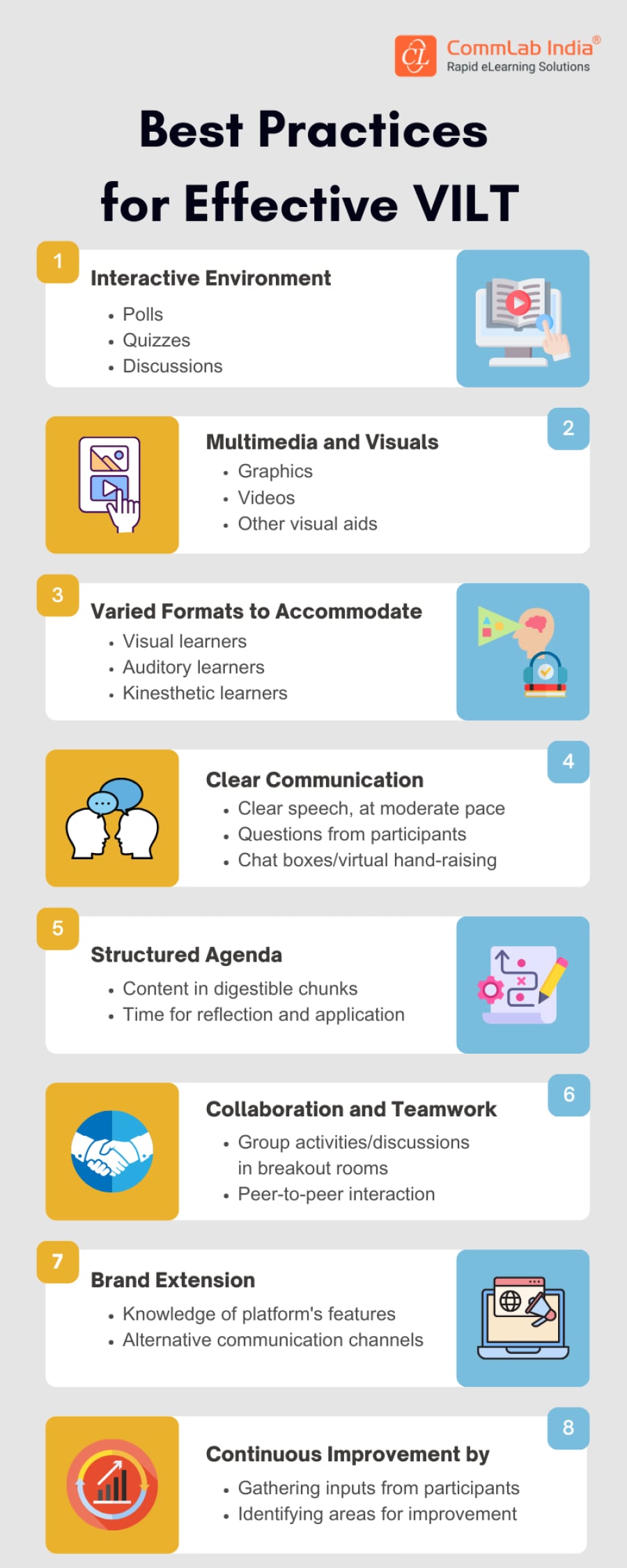Best Practices for Effective VILT [Infographic]
![Best Practices for Effective VILT [Infographic] Best Practices for Effective VILT [Infographic]](https://blog.commlabindia.com/hubfs/blogs/best-practices-effective-vilt-info.jpg)
The modern workforce thrives on flexibility and efficiency. While traditional Instructor-led Training (ILT) is valuable, it can struggle to meet these contemporary demands. In such situations, Virtual Instructor-Led Training (VILT) offers a compelling solution. It helps organizations replicate the classroom setting virtually! Instructors deliver training through digital platforms that set the ground for multiple benefits of VILT for both organizations and learners. In this blog, take a look at the benefits and then uncover the best practices that help you make the most of the VILT session.
Are you ready? Here we begin!
Benefits of VILT
VILT offers several advantages that enhance the learning experience and deliver a strong training ROI:
Reduces Costs
Let’s face it, costs associated with classroom training such as trainer travel, accommodation, and venue rentals can be significant. However, by opting for VILT, organizations can eliminate these expenses, leading to substantial cost savings.
→ Download Now: A Beginner’s Guide to Virtual Instructor-led Training
Offers Scalability
Traditional training methods are often limited by venue capacity and logistics. However, with Virtual Instructor-led Training (VILT), organizations can accommodate large and geographically dispersed audiences with ease. VILT platforms, such as Zoom, Microsoft Teams, Skype, etc., can seamlessly handle large numbers of participants, regardless of location. This allows organizations to train their global workforce simultaneously, even if they are spread across different countries or continents.
Fosters Engagement and Interactivity
Unlike traditional lectures, VILT sessions boost learner engagement and encourage active participation from learners. VILT platforms often incorporate interactive features like polls, quizzes, chat, breakout rooms, etc., that foster an engaging learning experience. In fact, polls and quizzes also help instructors gauge into understanding of learners and identify areas that need clarification.
Improves Knowledge Retention
VILT's interactive aspect and ability to cater to different learning styles lead to improved knowledge retention. Active participation through polls, discussions, chats, and activities helps learners process information more effectively. Additionally, VILT platforms often allow for recordings of the sessions, which learners can access later for review and reinforcement. This element helps solidify understanding and improve knowledge retention.
Streamlines Content Delivery and Updates
Often, digital learning platforms offer centralized content management systems. This enables organizations to revise and update their existing training materials easily. It helps ensure that everyone has access to the most current information. Apart from this, instructors can also integrate pre-recorded content modules into VILT sessions, creating a blended learning experience that caters to different learning preferences.
Best Practices for Effective VILT
In The End!
With the world going digital, Virtual Instructor-led Training is all set to transform the corporate training scenario. It offers a plethora of benefits that are hard to miss. With that said, it is important to note that as lucrative as these benefits are, delivering a high-impact VILT session is equally challenging. Now that you know the best practices, delivering an engaging, effective VILT session should be an easy ride. So what are you waiting for? Give VILT and the best practices a try! If you wish to gain a comprehensive idea about VILT, here’s a guide you shouldn’t miss. Check it out below!






